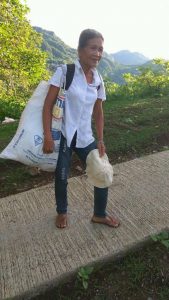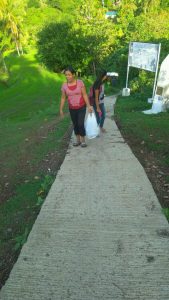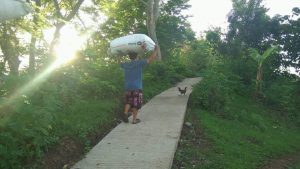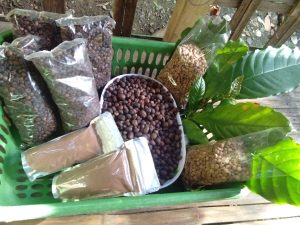Coffee has been an essential part of our early morning habit. For every cup of sipped coffee sipped, comes the story of farmers. Coffee growers from Tigbanaba have their own story to tell. Most of us have little idea how their high grade coffee goes to the market.
Seeing coffee farming as a central pathway to a better financial security, the community pooled themselves to address the laborious curves of their barangay road through a Kalahi-CIDSS funded pathway.
For them, better access in transporting Robusta coffee beans, means more food on the table and more money for children’s education.
Coffee farming is the main source of people’s livelihood in Sitio Buyuan, Barangay Tigbanaba. It has been supplying quality coffee beans to the different markets in Iloilo for more than a decade.
Tigbanaba, is one of the 46 barangays in the town of Igbaras, Iloilo. It is 10 kilometers away from the town proper. There are six sitios in Brgy. Tigbanaba namely Buyuan, Tarugan, Nasan, Lihan, Guimok and Baras.
The barangay is relatively isolated. It is rocky and steep. It is not accessible to four-wheeled vehicles. As one must cross a very narrow dirt and gravel path, making it difficult for the farmers to transport their products.
Coffee farmer Teddy Echalar described how difficult it was for them to transport their produce to the town market. Men have to carry on their shoulders the sacks of the dried coffee beans. They have to walk for almost an hour to reach Barangay Bagacay where a public utility jeepney is waiting.
Farmers have to pay P50 for every sack of coffee beans for haulers to take them to Barangay Bagacay, a fee that significantly cut into already narrow profit margins.
Farmers could not command a higher price for their high-grade coffee beans. There is no option left for them but to sell it in a much cheaper price to a coffee-making company.
Not all problems mostly revolved in transportation of coffee in Tigbanaba, but also in the daily lives of residents particularly the students.
Students from Brgy. Tigbanaba attends school at the nearby Igtalongon National High school. They have to walk for one kilometer to reach Barangay Bagacay.
The rugged terrain makes it difficult for students despite its short distance.
From Barangay Bagacay, they can ride a motorcycle to reach school.
During rainy season, it is even more difficult for students to traverse the steep and rocky road. At times, their school uniforms are tainted with mud. They also wear slippers to protect their shoes from damage.
“Pwerte gid kabudlay sa mga bata kay ang lao dangat sa tuhod, ang uniform nanda gakahigkuan pag-abot sa eskwelahan.” (It was very difficult for students since the mud is up to the knee level. They usually arrive at their school with dirty uniforms), said Anita Emano.
Seeing the disadvantages and inconvenience during rainy season and emergency cases, the barangay hoped for a better road – a concrete and passable road for motorcycles.
Through Kalahi-CIDSS, residents finally sighed on relief as they received funding for the concreting of barangay road for Tigbanaba.
Inspite of availability of funding and willingness of the community, the realization of the path in Sitio Buyuan was not a walk in the park because of the rugged terrain and narrow path that only one person could pass through.
Construction materials were carried by big trucks up to Brgy. Bagacay. From there, residents manually hauled the materials to the site. It usually takes them an hour to carry the materials to the site. Few short breaks are needed because of the terrain.
The community’s perseverance prevailed despite challenges in the implementation. The path walk was completed. It led them to different opportunities. About 60 households are benefitting from the project.
Echalar, who is also the Barangay Sub-Project Management Committee chairperson of Kalahi-CIDSS in Tigbanaba said the project was of a big help for their community for motorcycles can now access the barangay, thus, making it convenient for them.
“ Sang wara pa ang Kalahi, budlay gid kay ayawan kamano-mano sa pagtransport sang produkto. Mas magastuhan pa. Sa tulad, mas tawhay ron, hindi ron mangabudlay sa paghakwat pakadto sa banwa kay pwede ron masakay sa habal-habal” (When Kalahi was not yet implemented in our barangay, transporting our products to the market was really difficult since we manually hauled it. It adds up to our expenses. Now that Kalahi have funded our barangay road, we don’t need to exhaust ourselves from hauling the products to the town market for there are already motorcycles which we can hire.)
Transport of coffee had also greatly changed since the completion of the Kalahi project. Now, residents will just hire motorcycles to carry sacks of coffee to Brgy. Bagacay. “Hindi ron kami gakarga, ginapakarga nalang namon sa motor. Mas dasig ang pagtransport sang kape.”, Echalar. (Now, we don’t manually transport, we just hire motorcycles to bring it to Bagacay. It is much faster to transport coffee.)
The whole community of Tigbanaba is really thankful to Kalahi-CIDSS since it gave them the chance to taste economic progress.
Emano thanked Kalahi for funding their concrete road. “Gapasalamat gid ako ti bahol sa Kalahi nga gintaw-an kami kang proyekto nga makabulig sa kauswagan sang amon nga barangay. Makabulig gid sa turismo, transportasyon. Nakabulig gid sa adlaw adlaw nga pangabuhi.” (I am really thankful for Kalahi for they gave us a project that can bring development to barangay. It can also help us in our tourism and transportation. It can help us in our daily living).
The barangay road project at Tigbanaba is just a proof of how Kalahi-CIDSS helped spurring up economic activities in the rural areas.#
#DSWDMayMalasakit
#PatasNaPagtratoSaKomunidad
#MaagapAtMapagkalingangSerbisyo
#SerbisyongWalangPuwangSaKatiwalian
#SamaSamangPagkilosNgMayMalasakit





